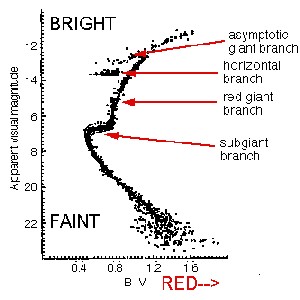 H-R diagram of 47 Tucanae
H-R diagram of 47 Tucanae
I started off my last post talking about the well-known properties of globular clusters, but I chose not to dive into the details of the stars inside the clusters. The stars really deserve an article all to themselves. Now is the time for that article.
Basically all of the stars in a globular cluster have the same age and formed under the same conditions. Observations of a globular cluster are a snapshot of one point along the evolutionary track of all these stars. Each star will have well defined properties depending on its mass and the age of the cluster. In the early 1900's, Ejnar Herstzprung and Henry Norris Russell made the first observations of this age and mass relation, thus earning the honor of having the model named after them. Not to be confused with more common corporate acronym, we now refer to the model describing the brightness and color of stars as the Hertzsprung-Russell diagram, or H-R diagram.
The H-R diagram shows the relationship between the brightness of a star and its color. In the figure at the top of this page, the y-axis shows the brightness of the stars in the cluster. The brightest stars are represented by the dots at the top of the figure. The faintest stars are near the bottom. The x-axis shows the color of these stars – red stars are on the right and blue stars are on the left.
All stars start on the main sequence, regardless of their mass. A star on the main sequence is burning hydrogen in its core. The more massive main sequence stars burn much more hydrogen, making them hotter, bluer, and brighter than the lower mass stars. The main sequence stars can be seen as the dots below the objects labeled “subgiant branch” in the H-R diagram at the top of the page. You should be able to see the bluer-brighter relationship that describes the main sequence stars.
